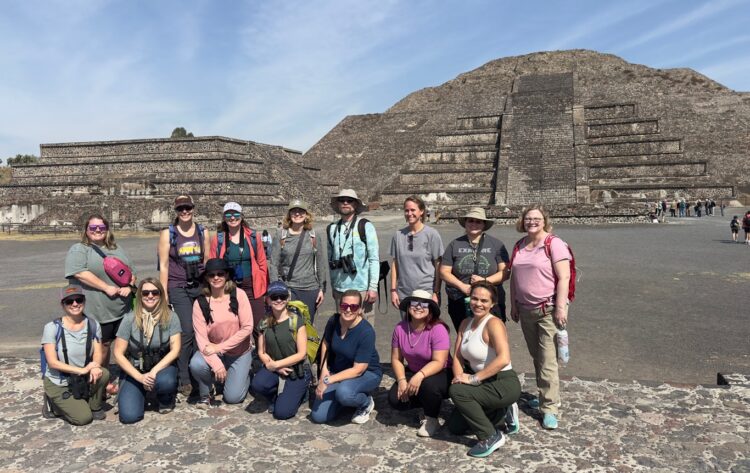
Hot air baloons over Teotihuacan at sunrise
We woke up to a beautiful sunrise and over 40 hot air balloons before venturing to the ruins of Teotihuacan. We were delighted to see various species of birds, including the brilliantly gorgeous Red Vermilion Flycatcher, an endemic species to Mexico. Our first stop was the pyramids at Teotihuacan. The steep climb up the stairs led us to ornate stone carvings including shapes of seashells, the Plumed Serpent, snakes, jaguars and symbology of natural resources. After taking in the splendor of the Pyramid of the Sun, the second largest ruin in the world, we walked the Avenue of the Dead toward the Temple of the Moon. The Pyramid of the Sun’s base is the same size as the Pyramids in Giza. We were treated to the colorful murals of the Quetzalpapalotl Palace, ornate murals depicting jaguars, owls, monarchs and other important ancestral gods. The rich reds were produced by an insect, the Cocchineal insect – a scale insect that lives on cacti.

Group in front of the Pyramid of the Moon
Before lunch we made a quick stop at a local market where we learned about the many uses of the agave plant. The agave plant provided fiber, paper, medicines, thread, and as an art medium among many other purposes. There are over 150 species of agave. We were lucky enough to see one about to bloom just outside our restaurant stop. Our lunch included a chicken dish prepared with prickly pear cactus, a native species that was grown adjacent to the resturant. Dessert featured the fruit of the pricklypear, and our drive around the area gave us a view of many additional varieties of succulents.
Following lunch we had an opportunity to take in the varied countryside as we drove north to the monarch butterfly overwintering areas. We stretched our legs and took advantage of birding opportunities at a lake along the highway, observing northern shovelers, blue-winged teal, grebes and non-breeding white-faced ibis, among many other species. Interestingly, the white-faced ibis does NOT have a white face outside of the breeding season, a reminder to not assume that common names are 100% accurate at all times. Along the drive we observed the changing landscape, noticing more green foliage in the trees, snow-covered mountains in the far distance and a gorgeous sunset. We were greeted to a nourishing meal before tucking in, excited for our first experience with the Monarchs happening on Friday!
